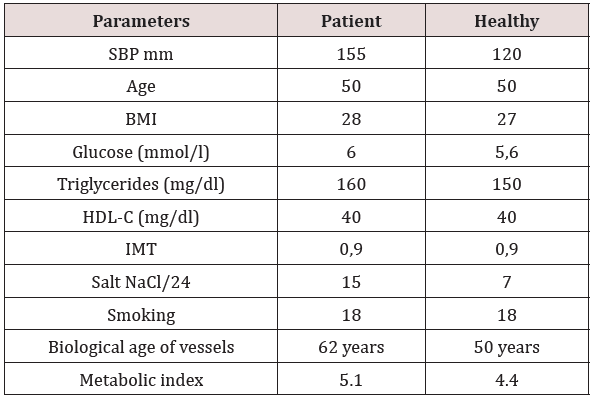Lupine Publishers | Open access Journal of Complementary and Alternative Medicine
Short Communication
It is noted, that today the population of Uzbekistan
unprecedentedly increases consumption of salt and have low
physical activity in general. Besides for the last 25 years, the
population of Uzbekistan was enlarged twice. Today such tendency
of population increase is followed by its aging. The positive aspect
of this phenomenon is augmentation of average life expectancy.
However, a negative side that the augmentation of life expectancy
doesn’t correspond to its quality. Deterioration first of all is bound
to augmentation of prevalence of age chronic diseases, such as a
hypertension. For example, today in Uzbekistan, one of three adults
has raised by the ABP, and excess weight occurs at every second
(WHO/STEPS 2014). As a result it caused double increasing of
visits of the doctor and total number of patients in general. The
purpose of our research was in developing the prognostic model
of the turnpike arteries biological age at hypertensive patients.
To study the arterial blood pressure daily profile at sick with the
arterial hypertension (AH) with the metabolic syndrome (MS) [1].
Material and Methods
The study included 96 healthy volunteers and 96 men with
arterial hypertension AH in average age of 56.06 ± 7.86 years,
diagnosed abdominal obesity (BMI 34.54 ± 3.83 kg/m
2) and
metabolic disorders. In order to estimate the clinical status, the
following risk factors were studied: elevated arterial BP, smoking;
clinical and biochemical parameters: 12-lead ECG; 24-hour Holter
ECG monitoring; exercise stress test; echocardiography (EchoCG);
carotid artery intima-media thickness (IMT) [2,3].
Prognostic Model
We selected clinical signs for creation of the prognostic table by
means of the method of the consecutive diagnostic procedure based
on a technique of the sequential analysis offered by A. Wald. For each
informative sign gradation of this or that indicator were selected
to equal the diagnostic value of each of indicators (Figure 1). On
the basis of local research grant analysis the calculator of risk was
developed to provide patients with AH I-II -degrees the important
prognostic information. We also considered that population of
modern Uzbekistan have tendencies of negative impact at vessels
damage such as: salt and the increased body weight. As a result,
nine best factors for stratification of risk at patients with the defect
vessels and raised SBP, including easy available, clinical parameters
were included in this calculator (Figure 1). We applied multistage
stratification of risk, based on nine parameters which were included
in the developed equation of nine factors [4]:
Figure 1: Prognostic model.

(a-SBP; b- IMT intima-media thickness; s- Salt; d-smoking;
e-age; *m- metabolic index *m= t x g / h2; i-BMI; t-
Triglycerides, g- Glucose; h- HDL-C).

During this experiment, patients noted informational
content of the calculator for the objective comprehension of their
cardiovascular status (Sensitivity–85 %, Specificity–63%) (Table
1). However long-term preventive effect, in prevention of the
recurrence was not confirmed [5-7].
Table 1: Example Clinical data.



Conclusion
On completion of the therapy clinical tests indicated the high
sensitivity at average specificity model that was acceptable in an
opportunity to estimate medical effect. Unfortunately, the calculator
could show the rate of damage vessels in the cases of actual disease,
but not in cases of its prediction or probable emergence.
Follow on Linkedin : https://www.linkedin.com/company/lupinepublishers
Follow on Twitter : https://twitter.com/lupine_online






No comments:
Post a Comment
Note: only a member of this blog may post a comment.